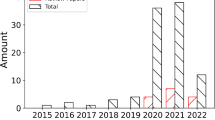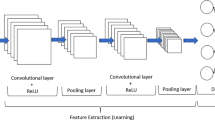Abstract
Early and accurate detection of plant diseases is necessary to maximize crop yield. The artificial intelligence based deep learning method plays a vital role in the detection of the diseases using a huge volume of plant leaves images. However, to detect disease with small datasets is a challenging task using deep learning methods. Transfer learning is one of the popular deep learning methods used to accurately detect plant disease with minimal plant image data. In this paper, the transfer learning-based deep convolution neural network model to identify tomato leaf disease has proposed. The model performs detection of disease using real-time images and stored tomato plant images. Furthermore, the performance of the proposed model is evaluated using adaptive moment estimation (Adam), stochastic gradient descent (SGD), and RMSprop optimizers. The experimental result demonstrates that the proposed model using the transfer learning approach is effective in automated tomato leaf disease classification. The Adam optimizer achieves better accuracy compared with SGD and RMSprop optimizers.













Similar content being viewed by others
References
Blancard D, D. (2012) Tomato diseases: identification, biology, and control: a colour handbook. CRC Press, Florida
Bouvrie J (2006) Notes on convolutional neural networks, Tech Rep.
Brahimi M, Boukhalfa K, Moussaoui A (2017) Deep learning for tomato diseases: classification and symptoms visualization. Appl Artif Intell 31(4):299–315
Chollet F (2017) Xception: deep learning with depthwise separable convolutions. In: Proceedings of the IEEE conference on computer vision and pattern recognition, 1251–1258.
Cruz A, Luvisi A, Bellis LD, Ampatzidis Y (2017) X-FIDO: An effective application for detecting olive quick decline syndrome with deep learning and data fusion. Front Plant Sci 8:1741
Durmuş H, Guneş EO, Kırcı M, (2017) Disease detection on the leaves of the tomato plants by using deep learning. In: 6th IEEE International Conference on Agro-Geoinformatics (2017) pp. 1–5.
Food and Agriculture Organization of the United Nations. Value of agricultural production-tomatoes. Food and agriculture data. 2015. https://www.fao.org/faostat/en/#data/QV/visualize
Goodfellow I, Bengio Y, Courville A (2016) Deep learning. MIT Press, [Online]. Available: https://www.deeplearningbook.org.
Hanssen IM, Lapidot M (2012) Major tomato viruses in the Mediterranean basin. Adv Virus Res Acad Press 84:31–66
Harvey CA, Rakotobe ZL, Rao NS, Dave R, Razafimahatratra H, Rabarijohn RH, Rajaofara H, MacKinnon JL (2014) Extreme vulnerability of smallholder farmers to agricultural risks and climate change in Madagascar. Phil Trans R Soc. https://doi.org/10.1098/rstb.2013.0089
Hinton H, Srivastava N, Swersky K (2012) Overview of mini-batch gradient descent. Neural Networks for Machine Learning, 575.
Hughes DP, Salathe M (2015) An open access repository of images on plant health to enable the development of mobile disease diagnostics. CoRR abs/1511.08060.
International Fund for Agricultural Development (2013) Smallholders, food security, and the environment. https://www.ifad.org/documents/38714170/39135645/smallholders_report.pdf/133e8903-0204-4e7d-a780-bca847933f2e
Kavukcuoglu K, Sermanet P, Boureau YL, Gregor K, Mathieu M, Cun YL (2010) Learning convolutional feature hierarchies for visual recognition, In Advances in neural information processing systems. 1090–1098.
Kayaa A, Kecelia AS, Catalb C, Yalica HY, Temucina H, Tekinerdoganb B (2019) Analysis of transfer learning for deep neural network based plant classification models. Comput Electron Agric 158:20–29
Kingma DP, Lei Ba J (2014) Adam: A Method For Stochastic Optimization, arXiv:1412.6980 https://arxiv.org/pdf/1412.6980.pdf, 2015.
Lin M, Chen Q, Yan S (2013) Network in network. arXiv:1312.4400
Mohanty SP, Hughes DP, Salathé M (2016) Using deep learning for image-based plant disease detection. Front Plant Sci 7:1419
Nair V, Hinton GE (2010) Rectified linear units improve restricted boltzmann machines, pp. 807–814. [Online]. Available:https://dl.acm.org/citation.cfm.
Pan SJ, Yang Q (2010) A survey on transfer learning. IEEE Trans Knowl Data Eng 22(10):1345–1359
Pollinators P (2016) Pollinators vital to our food supply under threat https://www.fao.org/news/story/en/item/384726/icode/
Rangarajan AK, Purushothaman R, Ramesh A (2018) Tomato crop disease classification using pre-trained deep learning algorithm, In: International Conference on Robotics and Smart Manufacturing (RoSMa2018), Procedia Computer Science 133:1040–1047.
Ruder S (2016) An overview of gradient descent optimization algorithms. https://arXiv:1609.04747.
Russakovsky O, Deng J, Su H, Krause J, Satheesh S, Ma S, Huang Z, Karpathy A, Khosla A, Bernstein M, Berg AC, Fei-Fei L (2015) ImageNet large scale visual recognition challenge. Int J Comput Vis 115(3):211–252
Singh V, Misra AK (2017) Detection of plant leaf diseases using image segmentation and soft computing techniques. Inf process Agric 4(1):41–49
Strange RN, Scott PR (2005) Plant disease: a threat to global food security. Annu Rev Phytopathol 43:83–116
Tai AP, Martin MV, Heald CL (2014) Threat to future global food security from climate change and ozone air pollution. Nat Clim Change 4(9):817–821
Vibhute A, Bodhe SK (2012) Applications of image processing in agriculture: a survey. Int J Comput Appl 52(2):34–40
Wang L, Xiong Y, Wang Z, Qiao Y (2015) Towards good practices for very deep two stream convnets, Comput Res Repos (CoRR) arXiv1507.02159.
Zeiler MD, Fergus R (2013) Stochastic pooling for regularization of deep convolutional neural networks. https://arXiv:1301.3557.
Zhang K, Wu Q, Liu A, Meng X (2018) Can deep learning identify tomato leaf disease. Adv Multimed 2018:1–10. https://doi.org/10.1155/2018/6710865
Zhou B, Lapedriza A, Xiao J, Torralba A, Oliva A (2014) Learning deep features for scene recognition using places database, In: Advances in neural information processing systems, 487–495.
Author information
Authors and Affiliations
Corresponding author
Additional information
Publisher's Note
Springer Nature remains neutral with regard to jurisdictional claims in published maps and institutional affiliations.
Rights and permissions
About this article
Cite this article
Thangaraj, R., Anandamurugan, S. & Kaliappan, V.K. Automated tomato leaf disease classification using transfer learning-based deep convolution neural network. J Plant Dis Prot 128, 73–86 (2021). https://doi.org/10.1007/s41348-020-00403-0
Received:
Accepted:
Published:
Issue Date:
DOI: https://doi.org/10.1007/s41348-020-00403-0




